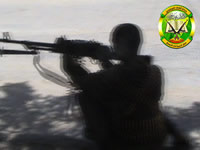|
|
|
Image of a Shabaab fighter from the terror group’s website. |
Al Shabaab, the radical Islamist terror group that serves as al Qaeda’s affiliate in East Africa, claimed it carried out a deadly suicide attack that killed more than 20 Somalis yesterday, including civilians, in the capital of Mogadishu.
A Shabaab suicide bomber rammed a van packed with explosives into a police checkpoint near the main seaport in Mogadishu. Witnesses said that the blast killed 10 police officers and security guards and more than a dozen civilians, Garowe reported.
Shabaab’s top spokesman, Sheikh Ali Mohamud Rage, who is also known as Ali Dheere, held a press conference in the Somali capital to announce the bombing. Rage claimed that the target was a Somali military base, and said only soldiers were killed and wounded in the attack.
“We successfully achieved our mission that was planned by our soldiers, we killed many Somali soldier (our enemies),” Rage told the media.
The terror group routinely holds press conferences in Mogadishu; African Union and Somali forces control only small areas of the capital and are unable to stop the terror group from operating in the open.
Over the past several years, Shabaab has targeted African Union and Somali forces, as well as the Somali government, in a number of suicide attacks. Shabaab launched four suicide attacks between Aug. 23, 2010 and Sept. 20, 2010. While two of the attacks ultimately failed to strike their intended targets, the Shabaab suicide bombers were able to penetrate several layers of security.
Shabaab has carried out 26 major suicide attacks in Somalia since September 2006, when the Islamic Courts Union usurped control of the government (the Islamic Courts Union was ousted from power a few months later, in an invasion by Ethiopian forces in December 2006). Several of the attacks have been carried out by American and British citizens who had left their home countries to join Shabaab.
Shabaab has also executed a suicide attack outside Somalia’s borders: the July 11, 2010 double suicide attack in Kampala, Uganda, that killed 74 people. It was carried out by a suicide cell called the Saleh ali Nabhan Brigade, which is named after the al Qaeda leader who served as Shabaab’s military commander before he was killed in a US special operations raid in September 2009.
Six “al Qaeda-linked foreign fighters” killed in Mogadishu
African Union forces claimed that six “al Qaeda-linked foreign fighters” were killed during clashes in Mogadishu over the past three days. The fighters are said to be “from Yemen, Pakistan, Kenya, India, and Syria,” according to DPA.
Foreign al Qaeda fighters are occasionally killed and wounded while fighting Somali and African Union forces. In December 2010, a Yemeni commander named Rajah Abu Khalid and 12 foreign fighters were killed during heavy fighting in the capital.
Background on Shabaab’s links to al Qaeda
Shabaab merged with al Qaeda in November 2008, after requesting to join the international terror group in September 2008. Top al Qaeda leaders Osama bin Laden, Ayman al Zawahiri, and Abu Yayha al Libi have praised Shabaab in propaganda tapes and encouraged the group to carry out attacks against the Somali government, neighboring countries, and the West. In late 2009, Osama bin Laden appointed Fazul Abdullah Mohammed to serve as al Qaeda’s operations chief in East Africa; the announcement was made at a ceremony in Mogadishu that was attended by Ahmad Godane Zubayr, Shabaab’s spiritual leader.
Over the past several years, al Qaeda commanders have taken over some of the top leadership positions in Shabaab. Fazul Abdullah Mohammed, who was indicted for his involvement in the 1998 attacks in Kenya and Tanzania along with Osama bin Laden, served as Shabaab’s top intelligence official before replacing Saleh Ali Saleh Nabhan as Shabaab’s top military leader.
Other foreign al Qaeda operatives also hold key leadership positions in Shabaab. Shaykh Muhammad Abu Fa’id, a Saudi citizen, serves as a top financier and a “manager” for Shabaab. Abu Musa Mombasa, a Pakistani citizen, serves as Shabaab’s chief of security and training. Mahmud Mujajir, a Sudanese citizen, is Shabaab’s chief of recruitment for suicide bombers. Abu Mansour al Amriki, a US citizen, serves as a military commander, recruiter, financier, and propagandist.
Al Qaeda’s central leadership, which is based in Pakistan, recently instructed Shabaab to downplay its links to the terror group but to continue to target US interests in the region, a senior US intelligence official who closely follows al Qaeda and Shabaab in East Africa told The Long War Journal.
Shabaab is considered by some US military and intelligence officials to be one of al Qaeda’s most successful affiliates. Shabaab has defeated Hizbul Islam, a rivial Islamist terror group, and has taken control of much of southern and central Somalia after waging a terror insurgency against Ethiopian forces and the UN-backed Transitional Federal Government.
In early 2009, Ethiopian forces withdrew from Somalia under fire and were replaced by some 6,000 African Union peacekeepers from Uganda and Burundi. The fractured and weak central government and African Union forces presently hold pockets within Mogadishu and little else.
Outside of Mogadishu, the government wields little influence. Shabaab currently controls almost all of the southern provinces and many of the central ones as well.









3 Comments
Somalia should be a major concern for us. But we continue to ignore it. This is where drones could be most effective. Sad.
Unfortunately, we simply have too much on our plate for a drone campaign in Somalia. I wish our partners would help pick up the slack in some of these other countries.
Grim
Where’s AFRICOM?